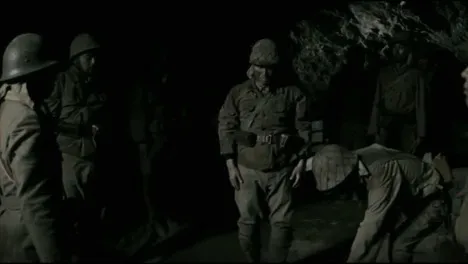“Letters from Iwo Jima” is a war drama film directed by Clint Eastwood, released in 2006. This film follows the perspective of Japanese soldiers fighting against the Americans during World War II on Iwo Jima Island. The film takes a deep dive into the emotional and psychological struggles faced by soldiers during war, as well as the strategic decision-making involved in planning and executing attacks.
The film starts with a team of Japanese archeologists discovering something on Iwo Jima island in 2005. This island was fought over by the Americans and the Japanese during the tail end of World War II. In 1994, the Americans overtook the islands in the Pacific Ocean previously occupied by the Japanese. If the Americans successfully took over Iwo Jima, they would have had a more strategic position to launch attacks on Japan.
Saigo, a former bakery worker, is among the Japanese soldiers charged with digging trenches along the beach of Iwo Jima. Lieutenant General Tadamichi Kuribayashi arrives on the scene to inspect the island. He saves Saigo from being beaten by Captain Tanida, who accuses Saigo of being unpatriotic. Kuribayashi orders all of the soldiers to dig trenches across the island.
Meanwhile, Lieutenant Colonel Baron Takeichi Nishi, a former Olympic gold medalist in track-and-field, and Kuribayashi argue with other high-ranking officers over the strategic approach on the island. While Kuribayashi wants to hold the island to defend against the Americans, others want Japan to strike back.
As the war progresses, several problems arise for the Japanese soldiers on Iwo Jima. They face malnutrition, disease, and a lack of resources. Many soldiers succumb to illness and die, which leads Saigo to suspect Shimizu, an incoming soldier, of being a military spy. The Americans launch an attack on the island, causing many Japanese soldiers to lose their lives.
Eventually, the American troops land on the island, and they manage to penetrate the Japanese defense line and attack the Suribachi Mountain. Saigo is then ordered to retrieve additional weapons from Captain Tanida. During this mission, he overhears Kuribayashi communicating with Tanida using a radio, where Kuribayashi orders Tanida to withdraw his troops. Tanida disobeys the order, instead forcing his troops to commit mass suicide.
Saigo manages to escape with Shimizu, while many other soldiers die in the battle. Several soldiers who survive are accused of deserting their posts. Kuribayashi steps in to defend them and explain to Lieutenant Ito that he gave orders for them to withdraw. The surviving Japanese soldiers plan their attack on the Americans, but their efforts ultimately fail, and many more soldiers lose their lives.
This movie is different from other war movies as it not only shows war’s tactical and strategic face, but it also digs deep into the intricacies of the emotions and mental toughness of the soldiers on the battlefield. The situation on Iwo Jima is so difficult that even people like Saigo, a former bakery worker, find themselves in the middle of a ruthless and unforgiving warzone.
One of the movie’s strengths is its portrayal of the strategies and tactics utilized in wartime conditions. As Kuribayashi faces a decisive challenge in the form of overwhelming American forces, he chooses to hold the island until he can withdraw his soldiers. Kuribayashi’s decision brings short-term pain to his soldiers but saves lives in the long run.
Another aspect that the film tackles is the notion of honor in warfare. It shows how some officers view surrender as dishonorable, while others do not. Throughout the movie, soldiers struggle with their decision to either fight to their deaths or surrender.
In conclusion, “Letters from Iwo Jima” is an essential watch for anyone interested in war movies that go beyond merely portraying the battlefield action. The film takes the audience on a journey into the psychological and emotional struggles of the soldiers, as well as giving insight into the decision-making of high-ranking officers during war. Through its intricate portrayal of strategy and emotion, the film delivers a powerful message about the dark side of warfare.




